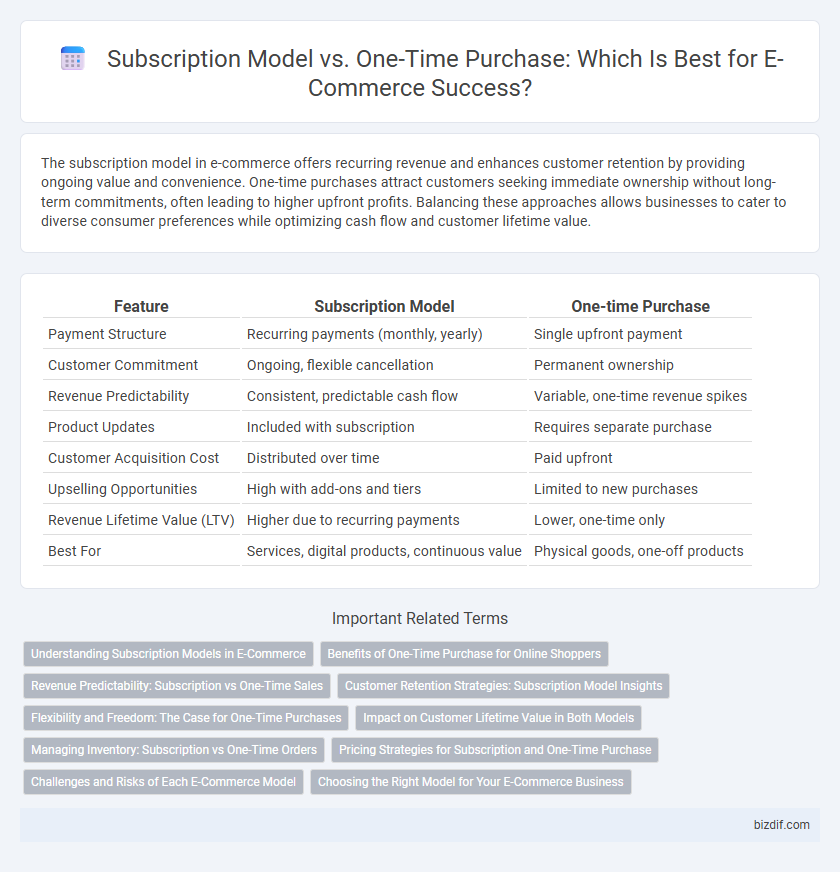The subscription model in e-commerce offers recurring revenue and enhances customer retention by providing ongoing value and convenience. One-time purchases attract customers seeking immediate ownership without long-term commitments, often leading to higher upfront profits. Balancing these approaches allows businesses to cater to diverse consumer preferences while optimizing cash flow and customer lifetime value.
Table of Comparison
| Feature | Subscription Model | One-time Purchase |
|---|---|---|
| Payment Structure | Recurring payments (monthly, yearly) | Single upfront payment |
| Customer Commitment | Ongoing, flexible cancellation | Permanent ownership |
| Revenue Predictability | Consistent, predictable cash flow | Variable, one-time revenue spikes |
| Product Updates | Included with subscription | Requires separate purchase |
| Customer Acquisition Cost | Distributed over time | Paid upfront |
| Upselling Opportunities | High with add-ons and tiers | Limited to new purchases |
| Revenue Lifetime Value (LTV) | Higher due to recurring payments | Lower, one-time only |
| Best For | Services, digital products, continuous value | Physical goods, one-off products |
Understanding Subscription Models in E-Commerce
Subscription models in e-commerce provide customers with recurring product or service deliveries at regular intervals, enhancing customer retention and predictable revenue streams. These models often leverage data analytics to personalize offerings and optimize customer lifetime value. Compared to one-time purchases, subscription models create deeper brand engagement through continuous interaction and convenience.
Benefits of One-Time Purchase for Online Shoppers
One-time purchases offer online shoppers full ownership immediately without ongoing commitments, making them ideal for those seeking flexibility and control over their spending. This model eliminates recurring charges, reducing financial uncertainty and simplifying budgeting for consumers. Online retailers benefit by attracting customers who prefer straightforward transactions without subscription complexities.
Revenue Predictability: Subscription vs One-Time Sales
Subscription models offer steady, predictable revenue streams through recurring payments, enhancing cash flow forecasting and financial planning for e-commerce businesses. One-time purchases generate immediate revenue spikes but lack long-term predictability, making sales dependent on fluctuating customer demand. Reliable subscription income supports growth strategies and customer lifetime value optimization, contrasting with the variable nature of one-time sales revenue.
Customer Retention Strategies: Subscription Model Insights
Subscription models enhance customer retention by providing consistent value through regular product delivery and personalized experiences, fostering long-term loyalty. Data shows subscription services achieve higher customer lifetime value (CLV) compared to one-time purchases due to ongoing engagement and predictable revenue streams. Leveraging subscription insights, e-commerce businesses can optimize retention by incorporating tailored recommendations, exclusive offers, and flexible plans that meet evolving consumer needs.
Flexibility and Freedom: The Case for One-Time Purchases
One-time purchases offer unmatched flexibility, allowing customers to buy products without binding commitments or recurring fees, which appeals to those valuing control over spending. This model empowers consumers to make decisions based on immediate needs rather than long-term obligations, enhancing satisfaction and reducing buyer's remorse. E-commerce platforms benefit from one-time purchases by attracting a diverse customer base seeking spontaneity and freedom in their shopping experience.
Impact on Customer Lifetime Value in Both Models
The subscription model significantly boosts Customer Lifetime Value (CLV) by securing recurring revenue and enhancing customer retention through continuous engagement and personalized experiences. In contrast, the one-time purchase model generates immediate revenue but often results in lower CLV due to limited repeat interactions and reduced opportunities for upselling. Optimizing subscription offerings with flexible plans and exclusive benefits can further maximize CLV by encouraging long-term loyalty and higher customer satisfaction.
Managing Inventory: Subscription vs One-Time Orders
Subscription models enable businesses to forecast demand with greater accuracy, reducing inventory holding costs and minimizing stockouts by leveraging predictable, recurring order patterns. One-time purchases demand more flexible inventory management strategies due to fluctuating order volumes and unpredictable customer purchasing behavior. Efficient integration of inventory management software with real-time sales data is crucial for balancing stock levels and optimizing fulfillment in both subscription-based and one-time order e-commerce models.
Pricing Strategies for Subscription and One-Time Purchase
Subscription models utilize tiered pricing strategies to attract varying customer segments, offering discounts for long-term commitments and bundling options that increase customer lifetime value. One-time purchase pricing often emphasizes competitive, upfront cost advantages and promotional deals to drive immediate sales without recurring revenue. Effective e-commerce pricing strategies balance customer acquisition and retention by optimizing both subscription flexibility and one-time purchase appeal.
Challenges and Risks of Each E-Commerce Model
Subscription models in e-commerce face challenges such as customer churn, maintaining long-term subscriber engagement, and managing recurring billing complexities, which can lead to revenue unpredictability. One-time purchases risk lower customer lifetime value and increased acquisition costs due to repeat customer dependency, making scalability difficult. Both models must address inventory management and customer support challenges to optimize profitability and sustain growth.
Choosing the Right Model for Your E-Commerce Business
Selecting the ideal model between subscription and one-time purchase hinges on customer retention goals and revenue predictability in e-commerce. Subscription models drive recurring revenue and enhance customer lifetime value by encouraging continuous engagement, while one-time purchases cater to immediate, infrequent needs with simplicity and lower commitment. Analyze product type, target audience behavior, and cash flow requirements to determine which approach maximizes profitability and sustainable growth.
Subscription Model vs One-time Purchase Infographic

 bizdif.com
bizdif.com